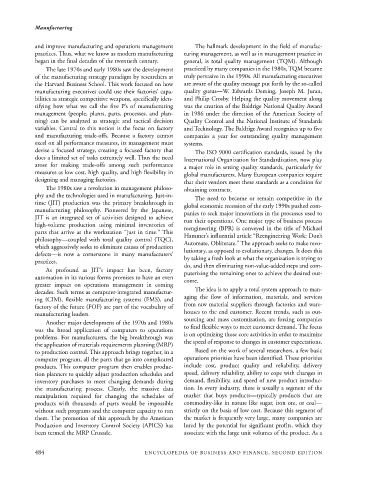Page 507 - Encyclopedia of Business and Finance
P. 507
eobf_M 7/5/06 3:15 PM Page 484
Manufacturing
and improve manufacturing and operations management The hallmark development in the field of manufac-
practices. Thus, what we know as modern manufacturing turing management, as well as in management practice in
began in the final decades of the twentieth century. general, is total quality management (TQM). Although
The late 1970s and early 1980s saw the development practiced by many companies in the 1980s, TQM became
of the manufacturing strategy paradigm by researchers at truly pervasive in the 1990s. All manufacturing executives
the Harvard Business School. This work focused on how are aware of the quality message put forth by the so-called
manufacturing executives could use their factories’ capa- quality gurus—W. Edwards Deming, Joseph M. Juran,
bilities as strategic competitive weapons, specifically iden- and Philip Crosby. Helping the quality movement along
tifying how what we call the five P’s of manufacturing was the creation of the Baldrige National Quality Award
management (people, plants, parts, processes, and plan- in 1986 under the direction of the American Society of
ning) can be analyzed as strategic and tactical decision Quality Control and the National Institute of Standards
variables. Central to this notion is the focus on factory and Technology. The Baldrige Award recognizes up to five
and manufacturing trade-offs. Because a factory cannot companies a year for outstanding quality management
excel on all performance measures, its management must systems.
devise a focused strategy, creating a focused factory that The ISO 9000 certification standards, issued by the
does a limited set of tasks extremely well. Thus the need International Organization for Standardization, now play
arose for making trade-offs among such performance
a major role in setting quality standards, particularly for
measures as low cost, high quality, and high flexibility in
global manufacturers. Many European companies require
designing and managing factories.
that their vendors meet these standards as a condition for
The 1980s saw a revolution in management philoso- obtaining contracts.
phy and the technologies used in manufacturing. Just-in- The need to become or remain competitive in the
time (JIT) production was the primary breakthrough in global economic recession of the early 1990s pushed com-
manufacturing philosophy. Pioneered by the Japanese,
panies to seek major innovations in the processes used to
JIT is an integrated set of activities designed to achieve
run their operations. One major type of business process
high-volume production using minimal inventories of reengineering (BPR) is conveyed in the title of Michael
parts that arrive at the workstation “just in time.” This
Hammer’s influential article “Reengineering Work: Don’t
philosophy—coupled with total quality control (TQC),
Automate, Obliterate.” The approach seeks to make revo-
which aggressively seeks to eliminate causes of production lutionary, as opposed to evolutionary, changes. It does this
defects—is now a cornerstone in many manufacturers’
practices. by taking a fresh look at what the organization is trying to
do, and then eliminating non-value-added steps and com-
As profound as JIT’s impact has been, factory
automation in its various forms promises to have an even puterizing the remaining ones to achieve the desired out-
come.
greater impact on operations management in coming
decades. Such terms as computer-integrated manufactur- The idea is to apply a total system approach to man-
aging the flow of information, materials, and services
ing (CIM), flexible manufacturing systems (FMS), and
from raw material suppliers through factories and ware-
factory of the future (FOF) are part of the vocabulary of
manufacturing leaders. houses to the end customer. Recent trends, such as out-
sourcing and mass customization, are forcing companies
Another major development of the 1970s and 1980s
was the broad application of computers to operations to find flexible ways to meet customer demand. The focus
problems. For manufacturers, the big breakthrough was is on optimizing those core activities in order to maximize
the application of materials requirements planning (MRP) the speed of response to changes in customer expectations.
to production control. This approach brings together, in a Based on the work of several researchers, a few basic
computer program, all the parts that go into complicated operations priorities have been identified. These priorities
products. This computer program then enables produc- include cost, product quality and reliability, delivery
tion planners to quickly adjust production schedules and speed, delivery reliability, ability to cope with changes in
inventory purchases to meet changing demands during demand, flexibility, and speed of new product introduc-
the manufacturing process. Clearly, the massive data tion. In every industry, there is usually a segment of the
manipulation required for changing the schedules of market that buys products—typically products that are
products with thousands of parts would be impossible commodity-like in nature like sugar, iron ore, or coal—
without such programs and the computer capacity to run strictly on the basis of low cost. Because this segment of
them. The promotion of this approach by the American the market is frequently very large, many companies are
Production and Inventory Control Society (APICS) has lured by the potential for significant profits, which they
been termed the MRP Crusade. associate with the large unit volumes of the product. As a
484 ENCYCLOPEDIA OF BUSINESS AND FINANCE, SECOND EDITION

